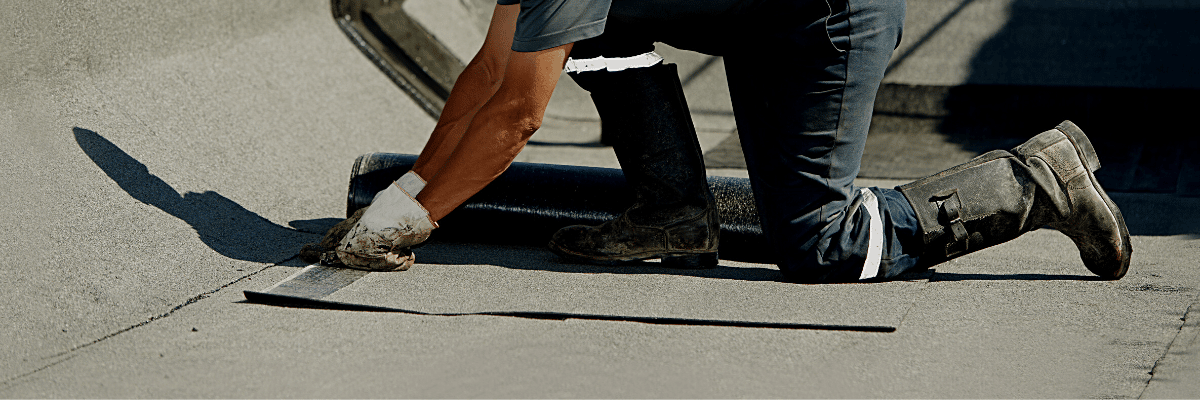Looking to replace your roof? Not sure which flat roof is right for you? Wish there was a crash course in understanding types of flat roof? It’s normal to feel overwhelmed by the information you find online and worried by the ‘cowboy roofer’ experiences of others.
The best first step you can take is to have all the knowledge you need to make an informed decision about your roof.
There are lots of different types of flat roofing with drawbacks and benefits for each choice. What’s important is finding out which option is going to give you the safest, most efficient and longest-lasting roof possible.
This blog is part of a series of articles explaining flat roof types. We’ll break down all the information you need in a simple way without any jargon. In this blog, we get to grips with felt roofs, which are one of the oldest and most common types of flat roofing.
What Is A Felt Roof?
Felt roofing can be found everywhere. It’s on garden sheds, extensions, commercial buildings and garages.
A felt roof consists of two or sometimes three layers of specialist roofing felt that comes in sheets. These sheets create a highly dense barrier against the elements. This type of roofing has been used for over a century but has evolved over time with new developments.
In modern-day roofing, the felting is made from a mix of bitumen (that super sticky stuff used in tarmac), special sand and a fibrous membrane to hold it all together.
Felt roofs have remained popular in large part because of how easy they are to install, but they do have a comparatively short lifespan.
How Does It Work?
Originally, felt was used as a way for homeowners to protect their property whilst they built their final roof over the top. That’s because the felting material has water-repelling properties and was really easy to put up while a slate or tile roof was under construction.
It’s the way the components work together that makes it a great short-term solution for flat roofs. The fibrous sheet and sand along with the protective bitumen act as a barrier for your roof, and when this is treated with tar, it fully seals the felt, making it more waterproof.

Why Have A Felt Roof?
Many DIY-loving homeowners and contractors choose to install felt on a flat roof for one reason – it’s cheap and easy.
There are plenty of tradesmen who will happily install a felt roof because it doesn’t require specialist training, only basic knowledge. Sadly, for some unlucky homeowners, this means felting is often botched or done ‘on the cheap’ with low-grade materials that reduce its lifespan even further.
Today, many felt roofs that were installed using cheap materials or poor methods to save money or time are failing and require replacement just a couple of years later.
What Are The Weaknesses Of A Felt Roof?
Felt roofing has the benefit of being easy to install with materials that are abundant and low-cost. However, that comes at a different kind of price.
Unfortunately, because of the extremely shallow slope of a flat roof, puddles can form on the top and over time, lichen and moss will take root and grow. As these absorb and hold onto water, they not only cause cracks and degradation to your roof felt, but they also can impact your energy use!
Felt roofs often have the shortest lifespan of the different roof types. Although they are durable, they are affected by weathering over time. Intense UV rays can cause the bitumen oils to dry up, which can reduce the necessary waterproofing element.
How Long Does It Last?
A felt roof installed by a qualified flat roofing specialist, using quality materials, is likely to last 5-10 years.
This can sound good to homeowners looking for a quick fix to a leaky roof, but when it comes time to repair or replace your felt roof it will feel more like a big, expensive issue.
If you’re in a home with a felt flat roof, consider how long ago yours was installed. Has it ever been checked professionally since? It might be time to check on it.
If you have a felt roof that’s over 5 years old, it is a good idea to get it checked out in case it is due for a replacement. The sad truth is that by choosing a lower-cost felt roof, it’ll cost you further down the line. With a little research, you may have found out about long-lasting alternatives and saved yourself stress, time and money…
What Are The Common Problems With Felt Roofs?
The biggest issue with felt roofs is that they don’t last for many years. But aside from their short-lived usefulness, they also come with a range of common problems:
- Manufacturer guarantees often cover the roofing product only, not your flat roof as a whole
- Cheap felt roofing products are easily available, meaning frequent low-quality installations
- Cold and hot temperatures will cause the materials to crack, peel and flake
- Vegetation grows freely on felt roofs, making the roof retain water and weight
- Installers need to use an open flame to apply and seal the felting, which can pose a big hazard to your home if they’re not properly trained
Still Unsure About Flat Roofing?
In summary, felt roofing is a great quick fix if you need a fast solution without too much hassle. But, if you’re looking for a flat roof to see you through many years to come, there are other options that will make the most of your investment.
But we know every home is different and you might still have questions.
Download our free roofing guide here to learn more about flat roof types so you can be assured in your decision-making.

